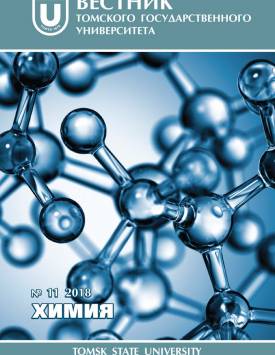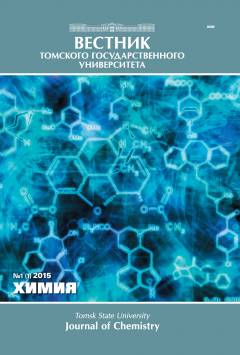Acceleration of VOC's vapor photocatalytic oxidation over TiO2 by the implementation of corona discharge and UVC radiation
Heterogeneous photocatalytic oxidation (PCO) over titanium dioxide (TO2) is one of the environmentally friendly methods of removing molecular impurities from the air, e.g., volatile organic compounds (VOCs). This method provides the complete mineralization of pollutants under ambient conditions into safe products (CO2, H2O, mineral acids). Therefore, PCO is considered as one of the most promising methods of air purification. However, this method has some limitations. A fundamental limitation of any pho-toinduced process is the limited number of light quanta. In order to increase the rate of such processes, researchers try to accelerate the oxidation processes by conducting a number of stages without the increase of light quanta number. Among others, a number of approaches are in saturation of the treated medium with high-reactivity particles, for example, ozone. This can be achieved by pretreating the gas mixture with a discharge plasma or treatment by UVC-light (100-280 nm). This work compares these two methods of ozone generation before the photocatalytic oxidation stage to identify the preferable method in practice. For controlling the ozone emission, an additional sample of the catalyst MnO2/TiO2 was placed into the combined purification system because it is capable of decomposing the ozone and further oxidizing organic impurities. The paper describes the influence of the PCO combination conditions on the rate of acetone vapor oxidation, their removal rate, and the accumulation of ozone as a byproduct of the process in an oxygen-containing atmosphere. It is shown that pre-treatment of the gas mixture before the photocatalytic stage contributes to the acceleration of the vapor oxidation processes. It is established that use of the ozone decomposition catalytic layer provides an additional acceleration of the observed oxidation process. Results obtained for the different values of the corona discharge current are given. They demonstrate the absence of direct proportionality in the effect of accelerating the oxidation process on the discharge current. The results show the acceleration of photocatalytic oxidation of acetone vapor over TiO2 due to the pretreatment of the gas medium by corona discharge plasma and catalytic aftertreatment on the MnO2/TiO2 layer. The obtained oxidation rate is 70% higher than the initial rates for a single photocatalytic oxidation, while the ozone concentration during the substrate oxidation process did not surpass the TLV level.
Keywords
фотокатализ,
окисление,
летучие органические соединения,
диоксид титана,
оксид марганца,
озон,
разложение озона,
коронный разряд,
фотолиз,
photocatalysis,
oxidation,
volatile organic compounds,
titanium dioxide,
manganese oxide,
ozone,
ozone decomposition,
corona discharge,
photolysisAuthors
| Lyulyukin Mikhail N. | Boreskov Institute of Catalysis, Siberian Branch of the Russian Academy of Sciences | lyulyukin@catalysis.ru |
| Gusachenko Egor A. | Boreskov Institute of Catalysis, Siberian Branch of the Russian Academy of Sciences | gusechenko@catalysis.ru |
| Kozlov Denis V. | Boreskov Institute of Catalysis, Siberian Branch of the Russian Academy of Sciences | kdv@catalysis.ru |
Всего: 3
References
Peral J., Domenech X., Ollis D.F. Heterogeneous photocatalysis for purification, decontamination and deodorization of air // J. Chem. Technol. Biotechnol. 1997. V. 70, № 2. P. 117-140.
Herrmann J. Heterogeneous photocatalysis: fundamentals and applications to the removal of various types of aqueous pollutants // Catal. Today. 1999. V. 53, № 1. P. 115-129.
Di Paola A. et al. A survey of photocatalytic materials for environmental remediation // J. Hazard. Mater. 2012. V. 211-212. P. 3-29.
Paz Y. Application of TiO2 photocatalysis for air treatment: Patents' overview // Appl. Catal. B: Environ. 2010. V. 99, № 3-4. P. 448-460.
Kavan L. et al. Electrochemical and photoelectrochemical investigation of single-crystal anatase // J. Am. Chem. Soc. 1996. V. 118, № 28. P. 6716-6723.
Mills A., Le Hunte S. An overview of semiconductor photocatalysis // J. Photochem. Photobiol. A Chem. 1997. V. 108, № 1. P. 1-35.
Hoffmann M.R. et al. Environmental Applications of Semiconductor Photocatalysis // Chem. Rev. 1995. V. 95, № 1. P. 69-96.
Linsebigler A.L., Lu G., Yates J.T. Photocatalysis on TiO2 Surfaces: Principles, Mechanisms, and Selected Results // Chem. Rev. 1995. V. 95, № 3. P. 735-758.
Fujishima A., Zhang X., Tryk D.A. TiO2 photocatalysis and related surface phenomena // Surf. Sci. Rep. 2008. V. 63, № 12. P. 515-582.
Ohtani B. Photocatalysis A to Z-What we know and what we do not know in a scientific sense // Journal of Photochemistry and Photobiology C: Photochemistry Reviews. 2010. V. 11, № 4. P. 157-178.
Augugliaro V. et al. The combination of heterogeneous photocatalysis with chemical and physical operations: a tool for improving the photoprocess performance // J. Photochem. Photobiol. C: Photochem. Rev. 2006. V. 7, № 4. P. 127-144.
Zhang P., Liu J. Photocatalytic degradation of trace hexane in the gas phase with and without ozone addition: Kinetic study // J. Photochem. Photobiol. A Chem. 2004. V. 167, № 2-3. P. 87-94.
Yu K.P., Lee G.W.M. Decomposition of gas-phase toluene by the combination of ozone and photocatalytic oxidation process (TiO2/UV, TiO2/UV/O3, and UV/O3) // Appl. Catal. B: Environ. 2007. V. 75, № 1-2. P. 29-38.
Pengyi Z. et al. A comparative study on decomposition of gaseous toluene by O3/UV, TiO2/UV and O3/TiO2/UV // Journal of Photochemistry and Photobiology A: Chemistry. 2003. V. 156, № 1-3. P. 189-194.
Van Durme J. et al. Efficient toluene abatement in indoor air by a plasma catalytic hybrid system // Appl. Catal. B Environ. 2007. V. 74, № 1-2. P. 161-169.
Urashima K., Chang J.S. Removal of volatile organic compounds from air streams and industrial flue gases by non-thermal plasma technology // IEEE Trans. Dielectr. Electr. Insul. 2000. V. 7, № 5. P. 602-614.
Xiao G. et al. Non-thermal plasmas for VOCs abatement // Plasma Chemistry and Plasma Processing. 2014. V. 34, № 5. 1033-1065 p.
Karuppiah J. et al. Abatement of mixture of volatile organic compounds (VOCs) in a catalytic non-thermal plasma reactor // J. Hazard. Mater. Elsevier B.V. 2012. V. 237-238. P. 283-289.
Assadi A.A., Bouzaza A., Wolbert D. Study of synergetic effect by surface discharge plasma / TiO2 combination for indoor air treatment: Sequential and continuous configurations at pilot scale // J. Photochem. Photobiol. A Chem. Elsevier B.V. 2015. V. 310. P. 148-154.
Vandenbroucke A.M. et al. Non-thermal plasmas for non-catalytic and catalytic VOC abatement // J. Hazard. Mater. Elsevier B.V. 2011. V. 195. P. 30-54.
Lyulyukin M.N., Besov A.S., Vorontsov A.V. Acetone and ethanol vapor oxidation via negative atmospheric corona discharge over titania-based catalysts // Appl. Catal. B: Environ. 2016. V. 183. P. 18-27.
Gallagher P.K., Schrey F., Prescott B. The thermal decomposition of aqueous manganese (II) nitrate solution // Thermochim. Acta. 1971. V. 2, № 5. P. 405-412.
Pelovski J., Shoumkov S. Thermal decomposition of aqueous solutions of manganese (II) nitrate // Reactions. 1992. V. 196. P. 503-509.
Dhandapani B., Oyama S.T. Gas phase ozone decomposition catalysts // Appl. Catal. B: Environ. Elsevier Science B.V. 1997. V. 11, № 2. P. 129-166.
Kozlov D., Besov A. Method of spectral subtraction of gas-phase fourier transform infrared (FT-IR) spectra by minimizing the spectrum length // Appl. Spectrosc. 2011. V. 65, № 8. P. 918-923.
Selishchev D.S. et al. TiO2 mediated photocatalytic oxidation of volatile organic compounds: Formation of CO as a harmful by-product // Appl. Catal. B Environ. Elsevier B.V. 2017. V. 200. P. 503-513.
Kolobov N.S. et al. UV-LED photocatalytic oxidation of carbon monoxide over TiO2 supported with noble metal nanoparticles // Chem. Eng. J. 2017. V. 314. P. 600-611.
ГОСТ 12.1.005-88 Система стандартов безопасности труда (ССБТ). Общие санитарно-гигиенические требования к воздуху рабочей зоны (с Изменением № 1). Государственный стандарт СССР, 1989.
EH40/2005 Workplace exposure limits. 2011. P. 1-74.
Li W., Gibbs G., Oyama S. Mechanism of ozone decomposition on a manganese oxide catalyst. 1. In situ Raman spectroscopy and ab initio molecular orbital calculations // J. Am. Chem. Soc. 1998. V. 120, № 35. P. 9041-9046.
Li W., Oyama S.T. Mechanism of ozone decomposition on a manganese oxide catalyst. 2. Steady-state and transient kinetic studies // J. Am. Chem. Soc. 1998. V. 120. № 35. P. 9047-9052.
Xi Y. et al. Acetone oxidation using ozone on manganese oxide catalysts // J. Phys. Chem. B. 2005. V. 109, № 37. P. 17587-17596.
Reed C., Xi Y., Oyama S.T. Distinguishing between reaction intermediates and spectators: A kinetic study of acetone oxidation using ozone on a silica-supported manganese oxide catalyst // J. Catal. 2005. V. 235, № 2. P. 378-392.
Lyulyukin M.N., Besov A.S., Vorontsov A.V. The influence of corona electrodes thickness on the efficiency of plasmachemical oxidation of acetone // Plasma Chem. Plasma Process. 2011. V. 31, № 1. P. 23-39.

